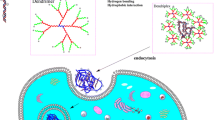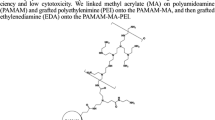Abstract
Purpose. The DNA association/dissociation properties of water-soluble cationic methacrylate polymers with closely related structures (poly(2-dimethylamino)ethyl methacrylate) [p(DMAEMA)], poly(2-(trimethylamino)ethyl methacrylate chloride) [p(TMAEMA)]) and the frequently used transfectant poly(L-lysine) were studied to gain a better insight into their transfection characteristics.
Methods. Association of DNA with different polymers and dissociation of the complexes, achieved by adding an excess of anionic polymers or salt, were studied by using spectroscopic techniques (fluorescence, circular dichroism (CD)), agarose gel electrophoresis and an enzymatic assay (DNase I treatment). The transfection efficiency of the polyplexes was evaluated in tissue culture with OVCAR-3 cells.
Results. Plasmid DNA complexed with either poly(L-lysine) or p(DMAEMA) was protected against digestion by DNase I. Fluorescence and CD spectroscopy as well as gel electrophoresis revealed that p(DMAEMA) with a relatively high molecular weight and poly(L-lysine) have similar DNA association/dissociation characteristics. Therefore, differences in transfection potential of the polyplexes cannot be ascribed to differences in binding characteristics, but are probably caused by other factors. As compared with the other polymers, p(TMAEMA) has a high affinity for DNA as was concluded from the observation that poly(aspartic acid) was unable to fully dissociate complexes containing this polymer. This fact might very well explain the low transfection efficiency of these polyplexes. p(DMAEM A) with a relatively low molecular weight probably has a low affinity for DNA, which might explain both the formation of DNA aggregates Ψ-DNA) and the low transfection potential obtained when using this polymer.
Conclusions. DNA association/dissociation studies shed light on the preferred characteristics of polymeric transfectants.
Similar content being viewed by others
REFERENCES
W. Zauner, M. Ogris, and E. Wagner. Polylysine-based transfection systems utilizing receptor-mediated delivery. Adv. Drug. Del. Rev. 30:97–113 (1998).
P. Van de Wetering, J. Y. Cherng, H. Talsma, and W. E. Hennink. Relation between transfection efficiency and cytotoxicity of poly(2-(dimethylamino)ethyl methacrylate)/plasmid complexes. J. Contr. Rel. 49:59–69 (1997).
A. V. Kavanov and V. A. Kavanov. DNA complexes with polycations for delivery of genetic material into cells. Bioconj. Chem. 6:7–20 (1995).
P. L. Felgner, Y. Barenholz, J. P. Behr, S. H. Cheng, P. Cullis, L. Huang, J. A. Jessee, L. Seymour, F. Szoka, A. R. Thierry, E. Wagner, and G. Wu. Nomenclature of synthetic gene delivery systems. Human Gene Ther. 8:511–512 (1997).
P. Van de Wetering, J. Y. Cherng, H. Talsma, D. J. A. Crommelin, and W. E. Hennink. 2-(Dimethylamino)ethyl methacrylate based (co)polymers as gene transfer agents. J. Contr. Rel. 53:145–153 (1998).
P. Van de Wetering, E. E. Moret, N. M. E. Schuurmans-Nieuwen-broek, M. J. Van Steenbergen, and W. E. Hennink. Structure-activity relationship of water-soluble cationic methacrylate/methacrylamide polymers for non-viral gene delivery (published).
O. Boussif, F. Lezoualc'h, M. A. Zanta, M. D. Mergny, D1. Scherman, B. Demenei, and Behr. A versatile vector for gene and oligonucleotide transfer into cells in culture and in vivo: polyethyleneimine. Proc. Nat. Acad. Sci. USA. 47:1160–1165 (1997).
A. Bout, D. Valerio, and B. J. Scholte. In vivo transfer and expression of the LacZ gene in the mouse lung. Exp. Lung Res. 19:193–202 (1993).
J. Y. Cherng, P. Van de Wetering, H. Talsma, D. J. A. Crommelin, and W. E. Hennink. Effect on size and serum proteins on transfection efficiency of poly(2(-dimethylamino)ethyl methacrylate)-plasmid nanoparticles. Pharm. Res. 13:1045–1049 (1996).
S. Katayose, and K. Kataoka. Water-soluble polyion complex associates of DNA and poly(ethyleneglycol)-poly(L-lysine) block copolymer. Bioconj. Chem. 8:702–707 (1997).
T. C. Hamilton, R. C. Young, W. M. McKoy, K. R. Grotzinger, J. A. Green, E. W. Chu, J. Whang-Penn, A. M. Rogan, W. R. Green, and R. F. Ozols. Characterization of a human ovarian carcinoma cell line (NIH:OVCAR-3) with androgen and estrogen receptors. Cancer Res. 43:5379–5389 (1983).
J. Sambrook, E. F. Fritsch, T. C. Maniatis, and Nolan (Ed). In: Molecular cloning: a laboratory manual. Cold Spring Harbor laboratory Press: New York, pp. 16.66–16.67 (1989).
D. A. Scudeiro, R. H. Schoemaker, K. D. Paull, A. Monks, S. Tierney, T. H. Nofziger, M. J. Currens, D. Seniff, and M. R. Boyd. Evaluation of a soluble tetrazolium/formazan assay for cell growth and drug sensitivity in culture using human and other tumor cell lines. Cancer Res. 48:4827–4833 (1988).
D. M. Gray, R. L. Ratliff, and M. R. Vaughan. Circular Dichroism Spectroscopy of DNA. Methods Enzymol., 211:389–405 (1992).
T. Akao, T. Fukumoto, H. Ihara, and A. Ito. Conformational change in DNA induced by cationic bilayer membranes. FEBS Lett. 391:215–218 (1996).
M. Weiskopf, and H. J. Li. Poly(L-lysine)-DNA interactions in NaCl solutions: B → C and B → Ψ transitions. Biopolymers. 16:669–684 (1977).
R. Ghirlando, E. J. Watchel, T. Arad, and A. Minsky. DNA packaging induced by micellar aggregates: a novel in vitro DNA condensation system. Biochemistry 31:7110–7119 (1992).
C. R. Middaugh, R. K. Evans, D. L. Montgomery, and D. R. Casimiro. Analysis of plasmid DNA from a pharmaceutical perspective. J. Pharm. Sci. 87:130–146 (1998).
V. I. Ivanov, L. E. Minchenkova, A. K. Schyolkina, and A. I. Poletayev. Different conformations of double stranded nucleic acid in solution as revealed by circular dichroism. Biopolymers 12:89–110 (1973).
P. Van de Wetering, N. J. Zuidam, M. J. van Steenbergen, O. A. G. J. van der Houwen, W. J. M. Underberg, and W. E. Hennink. A mechanistic study of the hydrolytic stability o poly(2-(dimethylamino)ethyl methacrylate). Macromolecules 31:8063–8068 (1998).
M. X. Tang, and F. C. Szoka. The influence of polymer structure on the interactions of cationic polymers with DNA and morphology of the resulting complexes. Gene Ther. 4:823–832 (1997).
S. J. Eastman, J. Siegel, A. E. Tousignant, S. H. Smith, S. H. Cheng, and R. K. Scheule. Biophysical characterization of cationic lipid:DNA complexes. Biochem. Biophys. Acta 1325:41–62 (1997).
R. P. Haughland. MTZ Spence (Ed). In: Handbook of fluorescent probes and research chemicals. Molecular Probes (Eugene, OR), p. 150 (1996).
P. R. Dash, V. Toncheva, E. Schacht, and L. W. Seymour. Synthetic polymers for vectorial delivery of DNA: characterization of polymer-DNA complexes by photon correlation spectroscopy and stability to nuclease degradation and disruption by polyanions in vitro. J. Contr. Rel. 48:269–276 (1998).
S. Katayose, and K. Kataoka. Remarkable increase in nuclease resistance of plasmid DNA through supramolecular assembly with poly(ethylene glycol)-poly(L-lysine) block copolymer. J. Pharm. Sci. 87:160–163 (1998).
J.-P. Yang, and L. Huang. Time-dependent maturation of cationic liposome-DNA complex for serum resistance. Gene Ther. 5:380–587 (1998).
T. Wink, J. de Beer, W. E. Hennink, A. Bult, and W. P. van Bennekom. Interaction between plasmid DNA and cationic polymers studied with surface plasmon resonance spectrometry. Anal. Chem. 71:801–805 (1999).
Author information
Authors and Affiliations
Corresponding author
Rights and permissions
About this article
Cite this article
Arigita, C., Zuidam, N.J., Crommelin, D.J.A. et al. Association and Dissociation Characteristics of Polymer/DNA Complexes Used for Gene Delivery. Pharm Res 16, 1534–1541 (1999). https://doi.org/10.1023/A:1015096302720
Issue Date:
DOI: https://doi.org/10.1023/A:1015096302720




